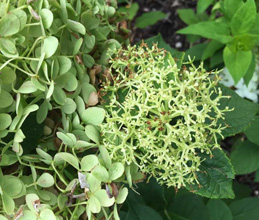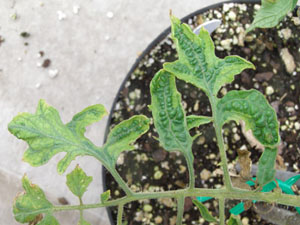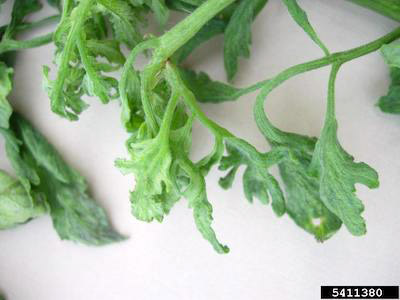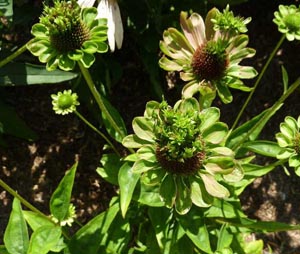Can a Plant Catch a Cold?

Tobacco Rattle Virus
By Elaine Pugh, Fairfax Master Gardener
Oddly enough, yes, it can. A cold is a virus. Just like people can catch a virus, a bacterial infection, a toenail fungus, or a pest like lice, a plant can catch its own separate line of viruses, bacterial infections, fungus invasions and have pest attacks. (And just like people do better if they eat right, sleep well and exercise, plants do better if they receive the proper amount of water, sunshine and nutrients in their diet.)
What is a virus?
A virus is a damaging, sub-microscopic parasite that infects an individual cell in a plant and then replicates itself to spread to other cells. The plant cells will not produce food and function properly. A virus can spread slowly through the leaves or fairly quickly if it attacks through the vascular system.
How do you know if your plant has a cold (virus)? What are possible symptoms? We all know the symptoms for the common cold. A plant with a virus may have some or all of the following symptoms:

Aster yellows on hydrangea
On the overall plant: deformed or stunted plant growth, additional unusual growths, smaller leaves and blossoms, necrotic lesions (dead spots) and/or reduced vegetable yield.
On leaves: mottling and mosaic patchwork of green and yellow areas over the surface of the leaf, ring spots, wavy line patterns, vein clearing with the rest of the leaf tissue still green and/or leaf crinkling.
How viruses spread
Like the common cold, a plant virus is contagious. It can be spread to other plants by insects like leaf hoppers or aphids; by mites, fungi or nematodes; by brushing against the plant and touching other similar plants; or by not cleaning tools thoroughly between pruning different plants. A virus can also exist for up to 2 years in infected soil or leaf debris.

Tobacco Mosaic Virus
Examples of viruses
The Tomato mosaic virus (ToMV) and tobacco mosaic (TMV) virus (Tobamovirus) are hard to distinguish from other common tomato viruses. The ToMV affects tomatoes, peppers, potatoes, apples, pears, cherries and numerous weeds, including pigweed and lamb’s quarters. TMV affects tobacco, cucumbers, lettuce, beets, peppers, tomatoes, petunias, as well as weeds such as jimsonweed and horsenettle.
Plants may have stunted growth and yellowing. Leaves may be smaller, become mottled light and dark green, curled or be otherwise malformed with spots of dead tissue. Fruit may be smaller, ripen unevenly, have yellowish rings or show internal browning just under the skin. Planting resistant varieties is the best prevention. Cross-referencing the University of Minnesota Extension article with the list of vegetables recommended for Virginia in the Master Gardener Handbook, Big Beef and Celebrity are both TMV resistant. Others resistant varieties will be listed with the code ToMV or TMV.

Cucumber mosaic virus on tomato leaves
The tobacco rattle virus (TRV) affects ornamentals such as astilbe, bleeding heart, coral bells (Heuchera), daffodil, epimedium, gladiolus, hyacinth, marigold, tulip and vinca, as well as vegetables such as beans, beets, peppers, potatoes and spinach.
The plant leaves may have blotchy light and dark discoloration on the leaves, yellow ring spots or line patterns, dead spots, yellow spots or streaks or notches on the leaves. The TRV is spread mainly by stubby-root nematodes (worm-like organisms in the soil) or mechanically when pruning or dividing plants. One option for prevention is to substitute plants that do not get TRV, such as annual phlox, carnation Sweet William and zinnia.
Aster yellows (Aster yellows phytoplasma) affects over 300 species of plants, including ornamentals such as aster, coneflower, chrysanthemum, hydrangea, marigold, petunia, snapdragon and Zinnias, as well as vegetables such as lettuce, carrots, tomatoes and celery. It also affects grasses, grains and numerous broad-leafed weeds.

Aster yellows on coneflower
Leaves may become yellow with green veins remaining. Growth slows and leaves may be smaller. As shown above, flowers may be deformed, lose their usual coloring, and/or have odd growths from their centers.
Aster yellows is a viral-like disease that is actually caused by a phytoplasma, an insect-transmitted microorganism, which is mainly spread by leaf hoppers.
What can you give the plant to cure it? Are these viruses an annoyance or a terminal illness? There is no cure for the common cold — you can just treat the symptoms. The same with a plant — there are no chemical treatments available to cure a plant virus. But unlike people, plants do not recover from a virus. Most viruses will not kill the plant, but the infected plant should be removed to prevent the spread of the disease to other plants.
Prevention is the key. So how can you help to prevent a plant from getting a virus?
- Purchase plants or seeds that are specifically listed as resistant to specific viruses.
- Use less susceptible plant species that don’t get the virus.
- Rotate planting beds for vegetables and flowers to prevent soil-laden virus contamination.
- Control insects with mesh nets.
- Control weeds. They may harbor the disease.
Conclusion: Comparing plant viruses to the common cold provides a unique way to look at plants, and gives a different perspective on how to keep them healthy. The key is to identify the problem, then prevent it.
References
• Virginia Master Gardener Handbook
• Tomato mosaic virus and tobacco mosaic virus, Anna Johnson, Michelle Grabowski, and Angela
Orshinsky, University of Minnesota Extension
• Tobacco Rattle, Rachel Zwieg and Brian Hudelson, University of Wisconsin Extension
• Disease-resistant tomato varieties, Cornell University
• Aster Yellows, Missouri Botanical Garden
… updated 2022